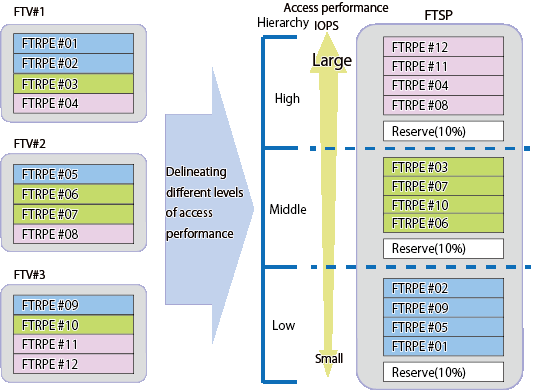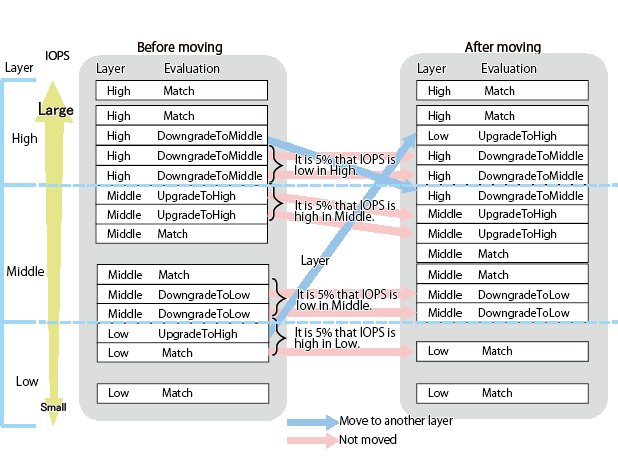The terms for execution of Automated Storage Tiering are configured as a Tiering policy.
According to the configured Tiering policy, Automated Storage Tiering automatically performs, in relation to FTV present in the Tier pool, relocation of data within the same device.
A Tiering policy can be assigned in relation to multiple Tier pools of either the same storage device or different storage devices.
Point
When the same Tiering policy is allocated in two or more Tier pools, the layer organization should be the same in all Tier pools of the allocation object.
Simplification of Tiering Policy Specification
The configuration of the range of IOPS values specified to each layer of the Tiering policy may be omitted.
It is also possible to specify the IOPS value of each layer.
The field for the configuration of the range of IOPS values is located under "Advanced Configuration of Tiering Policies" in the Create Tiering policy screen. In its initial state, the input range is not displayed.
The user can create a Tiering policy without being conscious of the configuration of the range of IOPS values.
In addition, Tiering policy can be created simply by specifying only the policy name. At this time, default values will be configured to other items of the Tiering policy. Refer to "Create Tiering Policy" in the ETERNUS SF Web Console Guide for information on the values that are configured.
If the range of IOPS setting is omitted, relocation is carried out according to the pool configuration. The logic for relocation is as follows.
FTRPEs are sorted in ascending order of IOPS value and the FTRPE with the highest IOPS value sorted to the top sub-pool, and so on.
When the Execution Mode is "Auto", all FTRPEs will be targeted. When the Execution Mode is "Semi-Auto" or "Manual", the FTRPEs contained in the FTVs to which relocation has been instructed will be targeted. However, a reserved region of approximately 10% will be prepared in each sub-pool in order to prevent the actual I/O of the sub-pools from being affected by relocation. The size of the reserved region is approximately 10% (fixed) of the size of the sub-pool. Moreover, as effects on performance of the actual I/O occur if relocation is performed frequently, FTRPEs that are present within approximately 5% of the boundaries of each layer do not move. Specifically, relocation is not performed with FTRPEs that fall under the following conditions.
Of FTRPEs which are applicable to the approximate 5% having a low IOPS, current layer is one layer higher than the layer after being moved.
Of FTRPEs which are applicable to the approximate 5% having a high IOPS, current layer is one layer lower than the layer after being moved.
Note
The reserved region is a region that is secured for the writing of new I/O data. When I/O is generated, data is written into the reserved region and located in such manner that approximately 10% is made empty upon relocation.
The overview of relocation, in cases when specification of the range of IOPS has been omitted, is as follows.
Figure 3.2 Summary of Relocation in Accordance with Pool Configuration

Figure 3.3 FTRPE Moving in Boundary of Each Sub-Pool

Detailed Configuration According to "Days of the Week subject to Evaluation" and "Days to exclude from Evaluation"
When creating a Tiering policy, it is possible to specify the "Days of the Week subject to Evaluation" and the "Days to exclude from Evaluation".
By specifying these items, it is possible to perform detailed operation of Automated Storage Tiering.